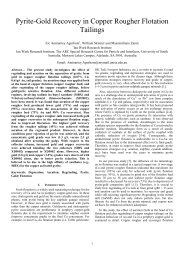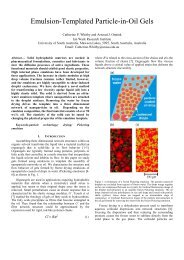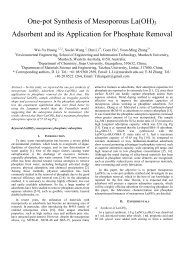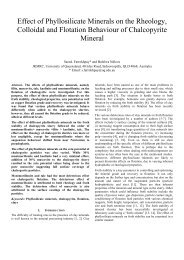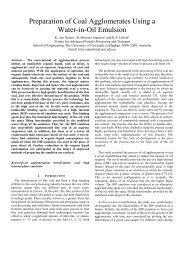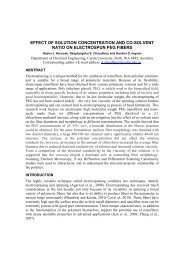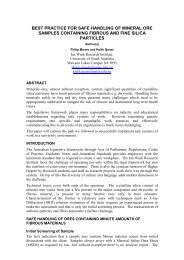a study on the calcination and sulfation behavior of limestone during ...
a study on the calcination and sulfation behavior of limestone during ...
a study on the calcination and sulfation behavior of limestone during ...
You also want an ePaper? Increase the reach of your titles
YUMPU automatically turns print PDFs into web optimized ePapers that Google loves.
Juan chen et al.<br />
flame <strong>during</strong> coal combusti<strong>on</strong>, which substantially increased <strong>the</strong> limest<strong>on</strong>e particle<br />
temperature to a level overweighing <strong>the</strong> inhibitory effect <strong>of</strong> CO2 partial pressure. As can<br />
be seen in fig. 2, adding 18% CaCO3 to coal combusted in DTF, increased <strong>the</strong> limest<strong>on</strong>e<br />
particle temperature from 1183 K to 1223 K in O2/CO2 <strong>and</strong> 1194 K in air.<br />
Unreacted CaCO3, %<br />
20<br />
15<br />
10<br />
5<br />
0<br />
Air<br />
Oxy-fuel (a)<br />
18% 5% 1%<br />
Mass percentage <strong>of</strong> CaCO3 in coal<br />
Unreacted CaCO3, %<br />
20<br />
15<br />
10<br />
5<br />
0<br />
Air+SO2<br />
Oxy-fuel+SO2 (b)<br />
18% 5% 1%<br />
Mass percentage <strong>of</strong> CaCO3 in coal<br />
Fig 3Variati<strong>on</strong> <strong>of</strong> <strong>the</strong> fracti<strong>on</strong>s <strong>of</strong> unreacted limest<strong>on</strong>e with <strong>the</strong> additi<strong>on</strong> <strong>of</strong> limest<strong>on</strong>e<br />
The mass ratio <strong>of</strong> limest<strong>on</strong>e to ash in coal <strong>and</strong> <strong>the</strong> c<strong>on</strong>centrati<strong>on</strong> <strong>of</strong> SO2 in flue gas were<br />
also c<strong>on</strong>firmed playing noticeable role <strong>on</strong> <strong>the</strong> extent <strong>of</strong> limest<strong>on</strong>e calcinati<strong>on</strong>. As<br />
dem<strong>on</strong>strated in fig. 3, in ei<strong>the</strong>r pure gas, air versus 27% O2/73% CO2 at a reactor<br />
length <strong>of</strong> 1200 mm in panel (a), with <strong>the</strong> decrease in <strong>the</strong> additi<strong>on</strong> percentage <strong>of</strong><br />
limest<strong>on</strong>e, i.e. increase in <strong>the</strong> mass ratio <strong>of</strong> coal ash/sulfur to limest<strong>on</strong>e, <strong>the</strong> fracti<strong>on</strong> <strong>of</strong><br />
unreacted CaCO3 was decreased drastically. If <strong>the</strong> reacti<strong>on</strong>s (1) <strong>and</strong> (2) shown above<br />
are <strong>the</strong> single routes for limest<strong>on</strong>e calcinati<strong>on</strong> <strong>and</strong> sulfati<strong>on</strong>, <strong>the</strong> presence <strong>of</strong> coal ash <strong>and</strong><br />
sulfur in <strong>the</strong> furnace should not affect <strong>the</strong> extent <strong>of</strong> <strong>the</strong> right shift <strong>of</strong> reacti<strong>on</strong> (1),<br />
because <strong>the</strong>y do not participant in this reacti<strong>on</strong>. The SO2 emitted from coal-bound<br />
sulphur is also insignificant, as <strong>the</strong> sulphur in coal <strong>on</strong>ly accounts for 0.9 wt%. It is thus<br />
referrable that ash (2.24% c<strong>on</strong>tent) plays <strong>the</strong> main role <strong>on</strong> <strong>the</strong> calcinati<strong>on</strong> extent <strong>of</strong><br />
limest<strong>on</strong>e. This clearly indicates <strong>the</strong> interacti<strong>on</strong> between limest<strong>on</strong>e <strong>and</strong> coal ash,<br />
according to <strong>the</strong> following reacti<strong>on</strong> (16) <strong>and</strong> (17), respectively.<br />
CaO+ Al O ⋅ SiO →CaO⋅<br />
Al O ⋅ SiO<br />
(16)<br />
2<br />
3<br />
2<br />
CaCO 3 + Al2O3<br />
⋅ SiO2<br />
→ CaO ⋅ Al2O3<br />
⋅ SiO2<br />
+ CO2<br />
(17)<br />
The Ca-Al-Si formed could be shed away from limest<strong>on</strong>e surface, which in turn ensured<br />
<strong>the</strong> exposure <strong>of</strong> fresh surface <strong>of</strong> limest<strong>on</strong>e to undergo decompositi<strong>on</strong> <strong>and</strong> react with SO2.<br />
The directi<strong>on</strong> reacti<strong>on</strong> (17) should occur slowly in O2/CO2 with high CO2 partial<br />
pressure when compared with <strong>the</strong> interacti<strong>on</strong> (16) between calcium oxide (derived from<br />
limest<strong>on</strong>e calcinati<strong>on</strong>) <strong>and</strong> coal ash which is predominant in air (Zhang et al, 2002), as<br />
indicated by <strong>the</strong> c<strong>on</strong>stantly higher unreacted CaCO3 fracti<strong>on</strong> over <strong>the</strong> mass ratio <strong>of</strong><br />
limest<strong>on</strong>e to coal in O2/CO2 than in air. Moreover, as suggested by <strong>the</strong> results for adding<br />
1000 ppmV SO2 in fig. 3(b), it is clear that <strong>the</strong> un-reacted limest<strong>on</strong>e fracti<strong>on</strong> was<br />
reduced quickly with <strong>the</strong> additi<strong>on</strong> <strong>of</strong> SO2 compared to that without SO2 additi<strong>on</strong> in<br />
panel (a). The limest<strong>on</strong>e calcinati<strong>on</strong> extent in O2/CO2 was even increased to <strong>the</strong> similar<br />
level with that obtained in air. This is a clear reflecti<strong>on</strong> <strong>of</strong> <strong>the</strong> importance <strong>of</strong> <strong>the</strong> direct<br />
sulfati<strong>on</strong> reacti<strong>on</strong> (3) at high SO2 c<strong>on</strong>centrati<strong>on</strong> in an oxy-fuel boiler.<br />
2<br />
3<br />
2<br />
6



